Dr. Kevin Robinson from Belmont University’s School of Physical Therapy was featured this week in a story in Canada’s National Post about his work with Nashville Predators star Shea Weber to improve his slap shot. You can read the story on the National Post’s website, or see the full article below.
Sean Fitz-Gerald, National Post · Monday, Nov. 15, 2010
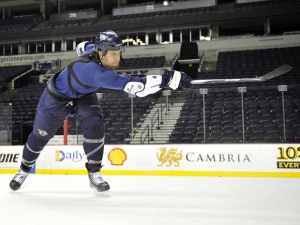 As a clinician and a professor of biomechanics who has worked with golfers and baseball players, Dr. Kevin Robinson was eager to apply science to a growing hockey legend. And that interest only grew after watching Shea Weber step into his first few slap shots after a recent practice.
As a clinician and a professor of biomechanics who has worked with golfers and baseball players, Dr. Kevin Robinson was eager to apply science to a growing hockey legend. And that interest only grew after watching Shea Weber step into his first few slap shots after a recent practice.
It is a shot that ripped through an Olympic hockey net this year, leaving behind what one news agency described as “scorch marks” on the mesh. It moves with the ferocity that has reportedly broken bones in no fewer than four teammates while elevating Weber, a first-year captain of the Nashville Predators, into an object of childhood wonder.
“With that guy on skates,” Robinson said, “I was a dwarf.”
Robinson, who teaches at Belmont University in Nashville, Tenn., analyzed Weber’s shot last month with help from a digital camera and a computer program. He asked the 6-foot-4, 234-pound defenceman to take about a dozen shots in open ice, and asked the same of Predators teammates Jordin Tootoo and Cody Franson for the sake of comparison.
After taking the top of each player’s backswing as a starting point, Robinson assessed the speed with which each player met the puck. Weber and Tootoo had similar mechanics in their shots, with their sticks perpendicular and their left arms parallel to the ice at the top of the top of their swing, and each took about 0.2 seconds to get down to the puck.
The difference?
“One of them is 5-foot-8, and the other one’s 6-foot-4,” Robinson said. “One of them is swinging a bigger stick, so the angular velocity is much faster.”
Angular velocity is a measure of speed, of which Weber showed in abundance. Robinson recorded the 25-year-old with a speed of 715 degrees per second — which suggests that, if his torso was able to spin like a top, Weber could rip through two full rotations of his shot in about a second.
Tootoo was clocked in at 668 degrees per second with Franson in third, at 405.
“What that speaks to is the tremendous amount of core strength, the strength of his abdominals, the muscles that stabilize his trunk,” Robinson said. “That’s the only way you can pull that off.”
Weber, the son of a mill worker in the British Columbia interior, began to find fame with his shot during the NHL all-star weekend last year. He fired a shot that hit 103.4 mph during the skills competition, finishing second only to the Boston Bruins’ 6-foot-9 defenceman, Zdeno Chara (105.4 mph).
It was at the Winter Olympics in Vancouver where Weber’s ability began acquiring some of its mythical proportions. He sent a shot screaming in from the point in the second period of Canada’s qualification game against Germany, opening a hole in the back of the net and forcing officials to consult video review to confirm what they had missed.
Canada won in a romp, and Canadian fans found their new favourite weapon.
“I’d never seen anything like that happen on a stage like the Olympics,” Weber said with a chuckle. “It’s pretty neat to have kids come up to you when you go home and bring that up.”
It was at home, in Sicamous, B.C., where Weber first developed his shot. He always loved to shoot the puck, and spent countless summer hours hammering shots into a second-hand net off a sheet of plywood laid on the grass outside his home.
“I would wreck my sticks before anything else,” Weber said. “And Dad wasn’t too happy about that. Just try to put an extra bit of tape on it after that.”
He said he usually goes through at least one composite stick a game with the Predators, even though he estimates he really only gets an opportunity to unleash the full fury of his shot once every three or four games.
“It might come a bit in spurts,” he said. “It might go in back-to-back games, where you get an opportunity to really blast it, and then you’d go a few games where you don’t really even get a chance to shoot anything.”
Weber had never put much thought into the physics of his shot, focusing instead on the mechanics of his delivery. He used to position his hand closer to the blade when he was younger, but moved it higher as he grew older and stronger, to the point where it is now mostly muscle memory.
He takes at least 100 shots a week in practice.
“The biggest thing for me is weight transfer,” Weber said. “Obviously, it’s got to be in sequence with everything else: from the weight transfer to how you’re distributing your power from your back foot to your front foot and, obviously, leaning on your stick to get the stick to torque and whip.”
He has taken 50 shots through Nashville’s first 15 games this season, second to Atlanta’s Dustin Byfuglien (66) for most by a defenceman in the league. Weber has two goals and five assists, but struggled to regain his dominant form while defence partner Ryan Suter was sidelined for nine games with a lower body injury.
Being known for his shot can also work against Weber, when teams scheme to pin someone higher on the point when the Predators have the man advantage. That forces him off a shooting lane and into passing mode, where he has to defer to an open teammate.
And he has to be mindful of those teammates in practice, when he consciously dials down the force of his point shots, conceding he has “had some unfortunate luck over the past few years with hitting guys on our team.”
“He’s using what God gave him, his height and his strength,” Robinson said. “That’s what separates him there.”
That core strength comes from the abdominal muscles, which can be strengthened with a diet of crunches and work with a medicine ball. Muscles in the hindquarters also help to stabilize the pelvis, which — in baseball and golf, as well as in hockey — should move first in the series of movements leading up contact.
“If those are in sync,” Robinson said, “then what you have is a really efficient delivery of force.”
Belmont University’s new teaching pharmacy was recently featured on NewsChannel5 in Nashville. You can view the report at the NewsChannel5 website, with accompanying story below:

 Once again this year, a group of students from the School of Physical Therapy, the School of Occupational Therapy, and the School of Nursing will be traveling to Guatemala over Spring Break for a missions trip. They are currently selling Christmas Ornaments as one of their fundraisers. They are for a wonderful cause and would be the perfect addition to your Christmas tree or make a great gift. They are only $8 and all the money goes towards the missions trip. Feel free to email Lacey Little at
Once again this year, a group of students from the School of Physical Therapy, the School of Occupational Therapy, and the School of Nursing will be traveling to Guatemala over Spring Break for a missions trip. They are currently selling Christmas Ornaments as one of their fundraisers. They are for a wonderful cause and would be the perfect addition to your Christmas tree or make a great gift. They are only $8 and all the money goes towards the missions trip. Feel free to email Lacey Little at  As a clinician and a professor of biomechanics who has worked with golfers and baseball players, Dr. Kevin Robinson was eager to apply science to a growing hockey legend. And that interest only grew after watching Shea Weber step into his first few slap shots after a recent practice.
As a clinician and a professor of biomechanics who has worked with golfers and baseball players, Dr. Kevin Robinson was eager to apply science to a growing hockey legend. And that interest only grew after watching Shea Weber step into his first few slap shots after a recent practice.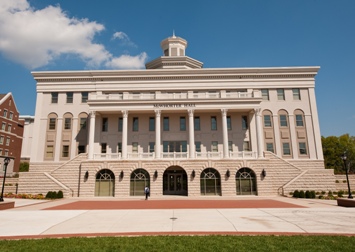 Belmont University’s McWhorter Hall—which houses the Schools of Pharmacy and Physical Therapy as well as the Department of Psychological Science—has received a Citation of Excellence Award in the national Learning By Design competition. The annual competition is sponsored by the National School Boards Association and Stratton Publishing and Marketing, Inc.
Belmont University’s McWhorter Hall—which houses the Schools of Pharmacy and Physical Therapy as well as the Department of Psychological Science—has received a Citation of Excellence Award in the national Learning By Design competition. The annual competition is sponsored by the National School Boards Association and Stratton Publishing and Marketing, Inc.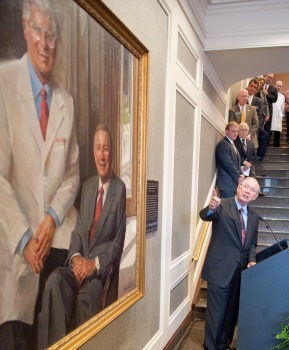 Governor Bredesen, others participate in ceremony honoring healthcare leader Clayton McWhorter and the late Fred McWhorter
Governor Bredesen, others participate in ceremony honoring healthcare leader Clayton McWhorter and the late Fred McWhorter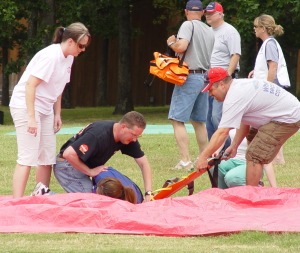 This year’s conference will feature a mass casualty disaster simulation presented by the Arkansas State University Regional Training Center for Disaster Preparedness Education. The Center is part of the University’s College of Nursing and Health Professions and offers certification courses in basic and advanced disaster life support. These courses provide training in areas such as detecting disasters, incident command, securing the scene and making it safe for responders to go in, assessing additional hazards, establishing triage and treatment, taking on and off hazardous materials suits, assessing and treating persons injured in disaster, and administering medications stored in the strategic national stockpile.
This year’s conference will feature a mass casualty disaster simulation presented by the Arkansas State University Regional Training Center for Disaster Preparedness Education. The Center is part of the University’s College of Nursing and Health Professions and offers certification courses in basic and advanced disaster life support. These courses provide training in areas such as detecting disasters, incident command, securing the scene and making it safe for responders to go in, assessing additional hazards, establishing triage and treatment, taking on and off hazardous materials suits, assessing and treating persons injured in disaster, and administering medications stored in the strategic national stockpile.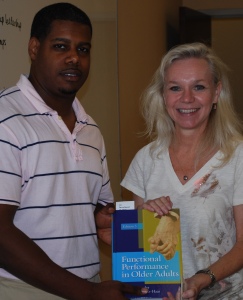 Two alumni of Belmont’s Master of Science program in Occupational Therapy (MSOT) recently presented current students in the program with textbooks to be used in the coming semester. Tim Sullivan and Angie Salvucci made the donation on behalf of Life Care.
Two alumni of Belmont’s Master of Science program in Occupational Therapy (MSOT) recently presented current students in the program with textbooks to be used in the coming semester. Tim Sullivan and Angie Salvucci made the donation on behalf of Life Care.